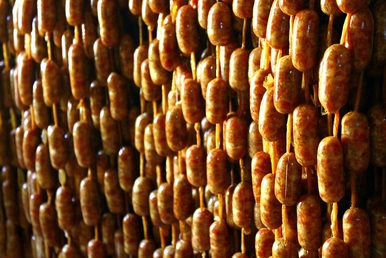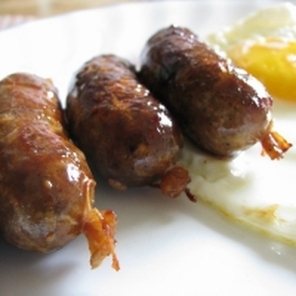
The Vigan longaganisa is a small and plump native sausage, good for about two or three bites.
It is garlicky and has a yellowish color. Although it is eaten anytime, even as a bread filling, it is
traditional favored as breakfast fare together with fried eggs and steamed or fried rice. It is best dipped in Ilocos vinegar with plenty of chili, garlic and onions.
Filipinos cook them in a pan with water. The longganisa cooks in its own fat after the water evaporates and is then cooked further until it slightly caramelizes. A tip to avoid crumbling is to place it in the freezer for a while before frying it.
It is garlicky and has a yellowish color. Although it is eaten anytime, even as a bread filling, it is
traditional favored as breakfast fare together with fried eggs and steamed or fried rice. It is best dipped in Ilocos vinegar with plenty of chili, garlic and onions.
Filipinos cook them in a pan with water. The longganisa cooks in its own fat after the water evaporates and is then cooked further until it slightly caramelizes. A tip to avoid crumbling is to place it in the freezer for a while before frying it.
| Vigan longganisa is said to be an influence of the Mexican salami. The tradition of making this native has existed since the period of the Spanish galleon trade. It is distinct from other Philippine sausages because of its use of the local sugar cane vinegar and Vigan-grown garlic, which are major products of the city as well. The Biguenos are so fiercely proud of their longganisa that they have made it as the product they would like to be most known for. They had it recognized as the city’s One Town, One Project (OTOP) selection under this national government program. They’ve endeavored throughout the years to be the top longganisa producer in the Philippines. |
Ingredients
- 2 lbs lean pork meat, finely chopped
- 1 lb pork fat, diced
- 1/4 tsp salitre (saltpeter)
- 1 ½ heads garlic, crushed
- 1/3 tsp ground bay leaf or 1 leaf finely chopped
- 3 tbsp brown sugar
- 1/4 cup soy sauce shopping list
- 1/3 cup cider vinegar
- 1-1/2 tsp salt
- 2 tsp sweet paprika
- 1 tsp coarsely cracked black pepper
- 1 tsp red pepper flakes (optional)
- sausage casing or 3 tbsp cornstarch if using skinless method
Procedure
- Combine all ingredients except casing and let stand for 1 hour.
- Fill casing w/ mixture.
- Twist and tie ends of casing with kitchen cord to form a link of sausage (usually at every 4 inches interval).
- Put mixture in a container with lid and cure in the refrigerator for 2-5 days. Best kept in chiller. Another curing method is to hang sausages above brick oven for 3-5 days.
- To cook, put desired amount of sausages in a skillet.
- Add 1/2 to 1 cup of water to come up to about 1/2 inch of skillet.
- Let simmer over medium heat until water evaporates, about 10 minutes. Prick sausages with fork.
- Stir-fry in its own fat for 3-5 minutes or until sausage is caramelized or skin turns reddish brown. Add a little oil if necessary.
- Serve hot with garlic rice, sunny side up or scrambled eggs, sliced tomatoes with spicy vinegar on the side.
For skinless method, add cornstarch to mixture, roll desired amount of mixture into balls using your hands, then roll mixture to form short sausages. Arrange side by side each other in a container with lid or wrap individually in wax paper. Keep covered and refrigerate for 3-5 days to cure before frying.
sources:
http://www.vigan.ph/longganisa.html,
http://www.grouprecipes.com/71718/vigan-longganisa---pork-sausage.html
philippinescuisine.blogspot.com
sources:
http://www.vigan.ph/longganisa.html,
http://www.grouprecipes.com/71718/vigan-longganisa---pork-sausage.html
philippinescuisine.blogspot.com




